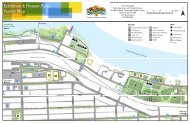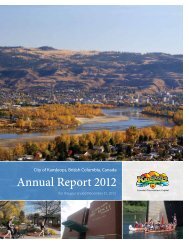Kamloops Heritage Register - City of Kamloops
Kamloops Heritage Register - City of Kamloops
Kamloops Heritage Register - City of Kamloops
Create successful ePaper yourself
Turn your PDF publications into a flip-book with our unique Google optimized e-Paper software.
CITY OF KAMLOOPS HERITAGE REGISTER 2007-2008<br />
Description <strong>of</strong> Historic Place<br />
The ‘Description <strong>of</strong> Historic Place’ section should paint a picture <strong>of</strong> the historic place in two or<br />
three sentences. It should describe very generally what the formal recognition applies to, and<br />
should make clear what elements on the property are included in the historic place and what is<br />
not. The description may also situate the place within its broader context, or setting, wherever<br />
this is helpful. The ‘Description <strong>of</strong> Historic Place’ answers the question: “What has been<br />
formally recognized”<br />
<strong>Heritage</strong> Value<br />
<strong>Heritage</strong> value may be defined as: the aesthetic, historic, scientific, cultural, social or spiritual<br />
importance or significance for past, present or future generations. The ‘<strong>Heritage</strong> Value’ section<br />
describes the core heritage value(s) on which the formal recognition <strong>of</strong> the place is based. It is<br />
intended to explain the significance <strong>of</strong> the historic place to a broad audience. It is also used to<br />
guide the identification <strong>of</strong> character-defining elements. ‘<strong>Heritage</strong> Value’ answers the question:<br />
“Why is this place important or significant”<br />
Historic places may have heritage value because they:<br />
• illustrate achievement in concept and design, technology, and/or planning, or a significant<br />
stage in the development <strong>of</strong> a community, province, territory or the nation<br />
• are associated with events that have contributed to patterns <strong>of</strong> history at the local,<br />
provincial, territorial or national levels<br />
• are associated with the lives <strong>of</strong> persons <strong>of</strong> historical importance at the local, provincial,<br />
territorial or national level<br />
• illustrate or symbolize in whole or in part a cultural tradition, way <strong>of</strong> life, or ideas<br />
important in the development <strong>of</strong> a community, province, territory or the nation.<br />
Character-Defining Elements<br />
The ‘Character-Defining Elements’ section identifies the principal features <strong>of</strong> the historic place<br />
that contribute to its heritage value. ‘Character-Defining Elements’ are: the materials, forms,<br />
location, spatial configurations, uses, and cultural associations or meanings that contribute to the<br />
heritage value <strong>of</strong> a historic place, which must be retained in order to preserve its heritage value.<br />
The information included under ‘Character-Defining Elements’ provides guidance to property<br />
owners, planners, architects and others involved in the conservation or rehabilitation <strong>of</strong> the<br />
historic place.<br />
Character-defining elements may be found in:<br />
• the style, massing, scale or composition <strong>of</strong> the historic place<br />
• features <strong>of</strong> the historic place related to its function<br />
• the interior spatial configurations, or exterior layout, <strong>of</strong> the historic place<br />
• the materials and craftsmanship <strong>of</strong> the historic place<br />
• the relationship between the historic place and its broader setting<br />
• traditional activities that continue to occur at the historic place<br />
• cultural associations or meanings that continue to be associated with the historic place.<br />
Donald Luxton & Associates Inc.: 2008<br />
- 3 -

















